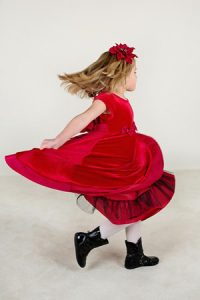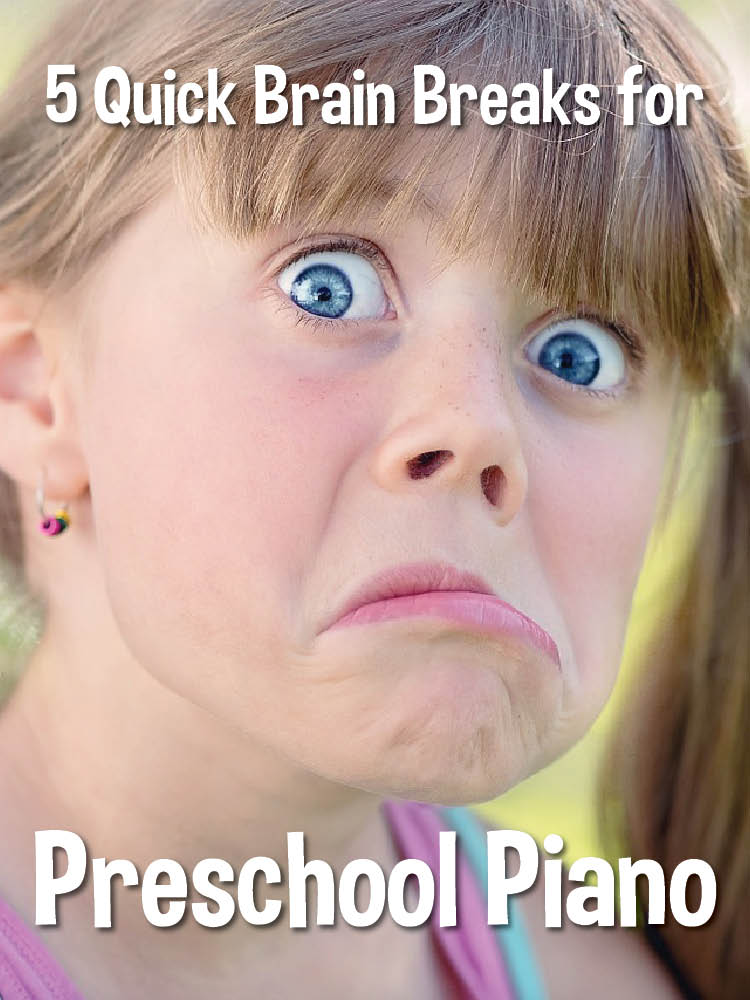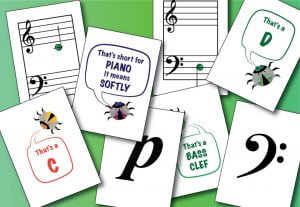If you teach preschoolers you likely already have a few brain breaks up your sleeve. And you are probably always on the lookout for more!
Kids this age are designed for movement. They’re not meant to be sitting still for prolonged periods of time. They’re explorers. This doesn’t mean they can’t learn to play piano, just that we need to get a little creative sometimes.
These five little activities can be done on the spur of the moment. As soon as you see your little piano student starting to lose focus you can act fast. Use one of these quick brain breaks for preschoolers and you’ll be back to the lesson plan in no time with renewed focus and energy.
1. Flashcard Dash
OK, get your selling face on. The more you convince your preschooler that this is a game the better! (It doesn’t really take that much convincing – just use your most enthusiastic voice.)
- Place some flashcards over the other side of the room.
- Ask for a particular card, e.g. “Find me an E”.
- Your student runs to get the card and back to place it on the music stand.
- Rinse and repeat.
Easy peasy, and you’ll be surprised how much fun preschoolers can have with this!
Optionally, you can ask your student to place the flashcard in a particular order on the stand. For example if they’re key name flashcards they could be placed from C up to B, or note value cards from smallest to biggest etc.
2. Higher or Lower
This is a super ear training game inspired by ‘Rhythm: One on One’ (I talked about this book in my last WOWZERS post here).
Higher or lower is one of the key concepts young beginners need to grasp in piano lessons. This activity combines that necessary skill with some movement and giggles.

- Have your preschooler curl up in a ball or sit on the floor.
- Start playing something on the piano. (A scale, arpeggio, or simple comping pattern is perfect.)
- Tell your student start standing up as the music gets higher, and go back down if it gets lower.
As your preschooler gets better at this you can make your changes faster or less obvious. For example, in the beginning you might play single notes jumping big intervals up and down the keyboard and gradually make the turns and directions more subtle. Great for training young musical ears!
3. Faster or Slower
This one has brought so much laughter into my preschool piano lessons!
- Play something with a steady andante tempo. A simple chord pattern works best.
- Ask your preschooler to march around the room in time to the beat.
- Begin gradually increasing or decreasing the tempo and tell your student to keep in time with you as you speed up or slow down.

Your preschooler may not be able to follow the beat this whole time precisely…in fact she might be miles off. That’s OK! She’s still learning about tempo and beat, even if she’s not quite getting it yet.
After you’ve tried the activity this way round, try flipping it.
- Ask your student what tempo she would like to go at (great for reviewing tempo terms).
- Start playing something at that tempo while your student marches.
- Tell your student to speed up or slow down as she likes, and you’ll follow her with your playing.
- Attempt to stay in time with your student as she’ll most likely choose to go as fast as possible!
This is much more than just a brain break for preschoolers, these are important skills for any beginning piano student. Following a beat and understanding tempo is essential in music making.
Just because you both end up in fits of laughter doesn’t mean it wasn’t a worthwhile use of lesson time!
(In fact I think that makes it all the more worthwhile. 😉 )
4. Sing it
Whenever we do a singing exercise, I always have my student get up off the bench. I have a second piano in my studio so I don’t need them to get up for me to take the keys, but I find it helpful to get them up whenever there’s an opportunity.
You can either have them stand, or take your seat. I’m not quite sure why, but my students love any opportunity to sit in the “teacher chair”. Perhaps it’s because it swivels… 🙂
Now that she’s off the bench it’s time to get your preschooler singing! Here’s some ways I use singing time in preschool piano lessons:
- Singing solfa (moveable do) along with scales
- Singing solfa with other patterns such as arpeggios
- Using solfa to help with interval training
- Singing the lyrics to a piece they’re working on
- Singing the lyrics to a piece that’s coming up in their book
- Using rhythm syllables to sing along to one of their pieces
- Simple sight singing exercises using solfa from my ‘Thinking Theory’ books (soon to be released)
All of these things can take only a few minutes out of lesson time but can make a huge difference to concentration levels for the rest of the lesson. Plus it gives us a chance to develop those often neglected ear training skills.
5. Wiggle
When all else fails, you need to go with the wiggle not against it.
Sometimes we need some silliness. If your student is falling off the bench, you may need to opt for a pure silliness break. Kids this age are just not meant to sit still for really long periods. So wiggle it out!

Tell your student she can have 30 seconds to get all the wiggles out. Then get up (yes you too!) and wiggle to their heart’s content. Jump up and down & dance around, then come back to the piano bench.
This won’t work for every student but for many kids that 30 seconds can be enough to get them back on track.
What’s your favourite brain break for preschoolers?
Do you have a go-to activity to combat the wiggles? How long do you find your littlest students can concentrate before needing a change?


As a Music teacher for 26 years, I have taught mainly secondary students
in their teens. Now I have been asked to teach a very smart, but also very active
5 year old girl and her 8 yr old sister. Typically, I am now challenged – that is good for the teacher. Love your activity games: the child moving up or down according to the dynamics. Further, the marching game to changing rythyms is a great idea.
Thank you so much.
Yours sincerely,
B. Peter Smith
Music Teacher
Victoria
Australia email: bpgsmi@yahoo.com.au
So happy it was helpful. Best of luck with your student!
Awesome, this is great for a fidgety child but what do you do with a student who is shy and doesn’t move? When my preschooler comes in at first she won’t play anything for me or do any big kind of marching or jumping or singing because she’s too shy and quiet! I’ve been using your build a keyboard game, and racing along the keys with sylvanian animals haha! and she loves that, and it normally gets her going, but I need a few more games like that that she doesn’t mind doing, because I can see her getting bored. When I do eventually convince her to play she’s very good actually!
It’s all about the relationship and her learning that she’s in a safe space and you won’t give her something she will “fail” at. Try to find out what she likes (a particular cartoon, dinosaurs, unicorns, or whatever) and bring that into everything you do.